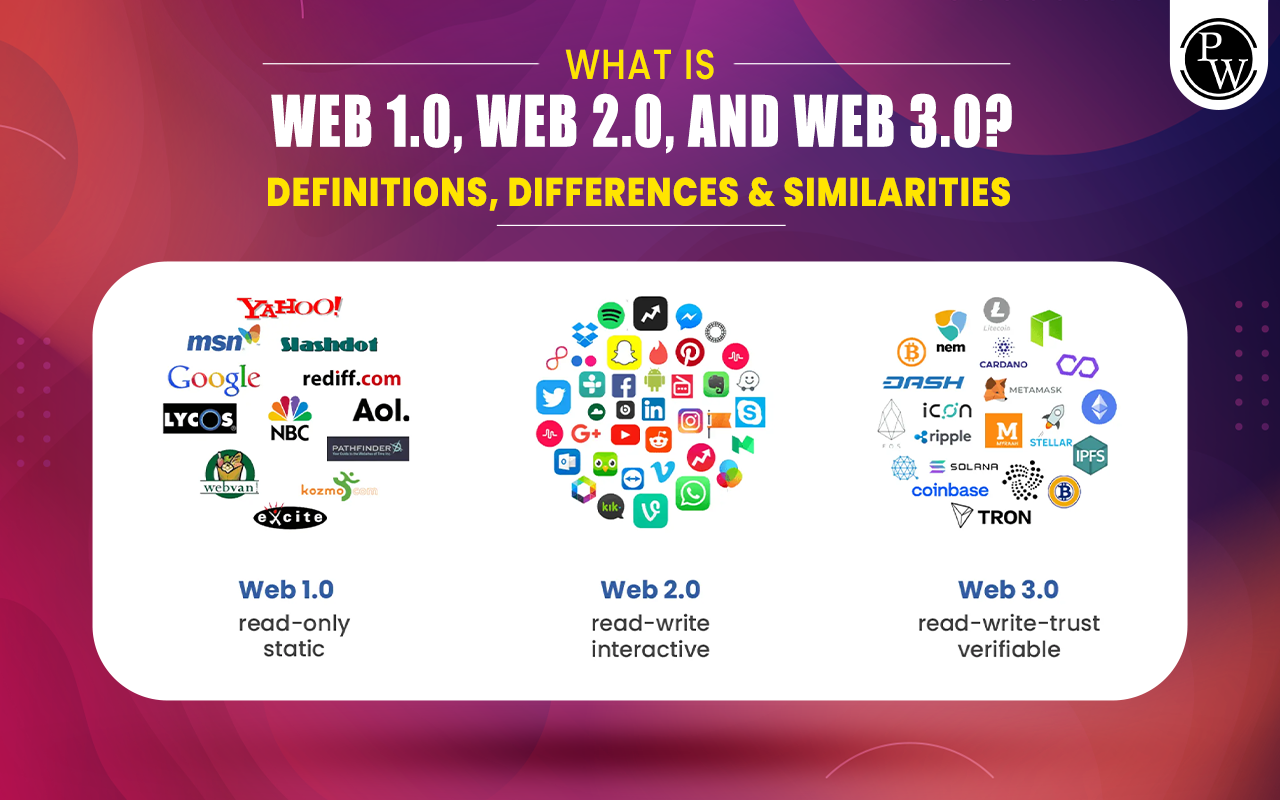Web 1.0, Web 2.0, Web 3.0: The internet is a vast and dynamic digital landscape. It has undergone significant transformations over the years. This evolution can be traced through the phases of Web 1.0, Web 2.0, and the emerging paradigm of Web 3.0. In this blog, we’ll talk about Web 1.0, Web 2.0, and Web 3.0.
What Is Web 1.0?
Web 1.0, often termed the “Static Web,” represents the internet’s nascent stage. During this era, websites functioned as digital brochures, offering static information without substantial user interaction. HTML was the primary language, and users acted as passive consumers rather than active contributors. The emphasis was on delivering information in a readable format, and popular websites included early versions of Yahoo! and AOL.
The web’s landscape was unidirectional, with information flowing from publishers to consumers. Interactivity was limited, and the user experience was akin to reading a digital document. The static nature of Web 1.0 laid the groundwork for the dynamic transformations that would follow.
What Is Web 2.0?
Web 2.0 changed how the internet works. It made the internet more dynamic and interactive. Instead of just static content, now people could create and share content. Social media and collaborative platforms became a big part of this shift. Websites evolved from one-way streets to interactive hubs, engaging users in a participatory digital environment.
Web 2.0 thrived on dynamic web pages, thanks to tech like AJAX. Facebook, Twitter, and YouTube emerged as hubs for user-generated content, promoting connectivity and collaboration. Blogs, forums, and wikis rose, transforming the internet into a space for user expression.
Beyond technology, Web 2.0 marked a cultural change. Users turned into content creators, moulding the digital landscape with their thoughts and creativity. This interactive model defined the web experience of that era.
What Is Web 3.0?
As we approach the next evolutionary phase, Web 3.0, or the “Semantic Web,” is emerging. Characterised by a focus on machine understanding, artificial intelligence, and decentralised technologies, Web 3.0 aims to create a more intelligent, interconnected, and secure internet.
Web 3.0 envisions machines understanding and interpreting data for personalised experiences. Decentralisation, aided by technologies like blockchain, aims to empower users with more control over their data and online identities. Artificial intelligence integration is anticipated to enhance search capabilities, making the web more intuitive and responsive.
Key Web 3.0 features include decentralised finance (DeFi) platforms, blockchain applications, and projects exploring AI-web convergence. As we enter this stage, the line between the real and virtual worlds will blur, presenting new possibilities and difficulties.
Also Read: 75 Basic Programming Problems and Tutorials for Practice
Uses of Web 1.0, Web 2.0, Web 3.0
We must closely study the specific purposes and features linked to each stage to understand how the internet is changing.
Web 1.0 Uses
During the era of Web 1.0, the primary function of websites was information dissemination. Websites served as digital brochures, presenting static content to users. The emphasis was on providing information in a readable format, akin to an online version of a traditional brochure. Examples of Web 1.0 use cases include early versions of search engines like Yahoo! and directories like AOL, where users accessed information in a top-down manner. Web 1.0 had limited user interaction, mostly involving navigating static web pages. The internet served as an information repository rather than an interactive space, focusing on transitioning from print to digital.
Web 2.0 Uses
With the arrival of Web 2.0, there was a significant shift to dynamic, interactive experiences from static content. User-generated content became crucial, with platforms enabling collaboration, sharing, and social interaction. Platforms like Facebook, Twitter, and YouTube became centres for user-generated content, while WordPress and Flickr empowered individuals to contribute to digital discussions. Web 2.0 went beyond information consumption; users actively participated by creating content, engaging in discussions, and sharing experiences. Social networking, a key aspect, connected individuals globally, forming online communities and fostering a culture of collaboration.
Web 3.0 Uses
Web 3.0 ushers in a new era of uses, driven by principles such as decentralisation, machine understanding, and artificial intelligence. Decentralised applications (DApps) in blockchain showcase a move to user-controlled systems. They run on decentralised networks, ditching the necessity for central authorities, providing users more command over their data.
In Web 3.0, artificial intelligence is key, enriching user experiences with personalised interactions. AI-driven applications interpret user preferences, providing tailored content and services. The semantic web, a core concept of Web 3.0, focuses on enabling machines to understand the context and meaning behind data, leading to more intelligent and context-aware experiences.
In addition to these advancements, Web 3.0 introduces concepts like decentralised finance (DeFi), where financial services operate on blockchain networks, offering users greater transparency and control over their assets. The uses of Web 3.0, therefore, extend beyond content creation and social interaction to include decentralised applications, personalised AI-driven experiences, and innovative financial services.
Potential and Pitfalls of Web 3.0
As we peer into the future, Web 3.0 holds promise but also introduces new challenges.
Potential
- Enhanced privacy and security: Decentralisation has the potential to reduce reliance on centralised authorities, offering increased privacy.
- Personalised experiences: AI-driven applications can tailor content and services to individual preferences.
Pitfalls
- Technological complexity: The integration of blockchain and AI may pose challenges for mainstream adoption.
- Ethical considerations: Issues related to data ownership, algorithmic biases, and accountability need careful consideration.
To navigate the potential gains and drawbacks, you need a subtle grasp of the changing digital scene.
Differences Between Web 1.0, Web 2.0, and Web 3.0:
The internet’s growth, from Web 1.0 to Web 3.0, shows notable shifts in tech, user engagement, and core principles. Grasping these differences gives key insights into the digital scene’s development.
Technological Evolution
Web 1.0: Static HTML Pages
- Web 1.0 was characterised by static HTML pages that offered limited interactivity.
- The focus was on providing information in a readable format, and the internet acted as an informational repository.
Web 2.0: Dynamic, Interactive Content with AJAX
- Web 2.0 introduced dynamic web pages enabled by technologies like Asynchronous JavaScript and XML (AJAX).
- This allowed for seamless and interactive user experiences, facilitating real-time updates without the need for page reloads.
Web 3.0: Decentralised Technologies like Blockchain and AI
- Web 3.0 emphasises decentralised technologies, including blockchain and artificial intelligence.
- The integration of blockchain ensures decentralised data ownership and trustless transactions, while AI enhances data interpretation and personalization.
User Interaction
Web 1.0: Passive Consumption of Content
- In the Web 1.0 era, users were passive consumers of information, with limited avenues for interaction.
- The internet primarily served as a one-way street, where content flowed from publishers to consumers.
Web 2.0: Active User Engagement, User-Generated Content
- Web 2.0 changed how users interact with content, allowing active engagement. Social media and user-generated content became key, turning the internet into a participatory space.
Web 3.0: More Personalized and Intelligent Interactions
- Web 3.0 envisions more personalised and intelligent interactions, facilitated by machine understanding and AI.
- Users can expect tailored experiences based on their preferences and behaviours, driven by advanced algorithms and semantic understanding.
Data Ownership
Web 1.0: Centralised Data Ownership
- Web 1.0 was characterised by centralised data ownership, where information was controlled by the entities managing the websites.
- Users had limited control over their data, and data privacy concerns were less pronounced.
Web 2.0: User-Contributed Content on Centralised Platforms
- Web 2.0 saw the rise of user-generated content on centralised platforms.
- While users actively contributed content, the ownership and control of that content remained largely centralised, leading to concerns about data privacy.
Web 3.0: Decentralised Data Ownership Through Blockchain
- In Web 3.0, technologies like blockchain grant users more authority over their data.
- Blockchain, being decentralised and cryptographic, guarantees trust in transactions and secures data ownership. It deals with past privacy worries effectively.
Also Read: What Is Full Stack Web Development? A Complete Guide
Similarities Between Web 1.0, Web 2.0, and Web 3.0
The web’s evolution goes through phases. Important to note are lasting elements persisting through these shifts, highlighting foundational aspects shaping the digital landscape.
Information Sharing
- Web 1.0: Early on, the web was mainly for publishers sharing information. Websites were static data repositories users could access.
- Web 2.0: A significant change occurred. Users actively contributed, sharing information. Social media platforms emerged, making the web dynamic, where individuals shared thoughts, experiences, and creations.
- Web 3.0: Despite advanced technologies in the Semantic Web, the core concept remains information sharing.
Communication
- Web 1.0: Interaction during the Web 1.0 era was limited, akin to a one-way communication channel. Users consumed information without active engagement or dialogue.
- Web 2.0: Social platforms became integral to the web experience, fostering communication and collaboration among users. This marked a significant shift towards a more interactive and socially connected internet.
- Web 3.0: Web 3.0 builds on this communicative aspect, introducing advanced, AI-powered communication. It aims for smarter and more responsive interactions between users and the digital realm.
User-Centric Experience
- Web 1.0: The user experience during Web 1.0 was predominantly passive. Users navigated static pages to consume information, lacking the interactive and personalised elements seen in later phases.
- Web 2.0: This phase marked a transition towards a more user-centric experience, with platforms designed to cater to user-generated content and the social aspects of the internet.
- Web 3.0: The evolution continues, with an increasing emphasis on personalised experiences. AI-driven applications in Web 3.0 aim to tailor content and services to individual preferences, creating a more bespoke user experience.
Continuity of Information Flow
- Web 1.0: Information flowed from publishers to users in a straightforward manner. The web served as a repository of static content.
- Web 2.0: The transition to Web 2.0 introduced a bidirectional flow of information. Users not only consumed information but also actively contributed, shaping the digital landscape.
- Web 3.0: Despite the integration of advanced technologies, the fundamental flow of information persists. In Web 3.0, the focus shifts towards more intelligent systems facilitating the flow of information, ensuring relevance and context in the data shared.
Evolutionary Nature
- Web 1.0 laid the initial groundwork, shaping how information was presented and accessed.
- Web 2.0 evolved significantly from Web 1.0, introducing user-generated content and interactive platforms.
- Taking the evolution a step further, Web 3.0 integrates cutting-edge technologies like blockchain and AI to refine and elevate the digital experience.
Features of Web 1.0, Web 2.0, and Web 3.0
Understanding the distinct features of each web phase is crucial for comprehending their evolution and impact on our digital experiences.
Web 1.0 Features
Static Content
- Web 1.0 was characterised by static HTML pages that presented information in a fixed format.
- Content was largely one-directional, flowing from the website owner to the user.
Limited User Interactivity
- Interaction on Web 1.0 was minimal, with users primarily acting as passive consumers of information.
- The focus was on delivering information rather than fostering user engagement.
Centralised Data Ownership
- Data ownership in Web 1.0 was centralised, with website owners and operators having control over the information published on their sites.
- Users had limited involvement in contributing or shaping the content.
Web 2.0 Features
User-Generated Content
- Web 2.0 marked a notable change with users taking the lead in content creation. Various platforms urged individuals to produce and share diverse content, spanning text, images, videos, and beyond. Blogs, forums, and social media gained significance as avenues for personal expression.
Social Networking
- This era witnessed the rise of social networking, exemplified by platforms such as Facebook, Twitter, and LinkedIn. These sites facilitated user connections, content sharing, and interactive engagement. The heightened focus on social interactions reshaped the internet, turning it into a more communal and collaborative environment.
Dynamic, Interactive Interfaces
- Web 2.0 transformed the internet by replacing static pages with dynamic, interactive interfaces. Innovations such as AJAX made real-time updates possible, enhancing user experiences with seamless and responsive features.
- Users could interact with content dynamically, leading to a more engaging and personalised online experience.
Web 3.0 Features
Decentralised Applications (DApps)
- Web 3.0 emphasises decentralisation. Decentralised applications (DApps) use blockchain, ensuring trustless, peer-to-peer interactions. Blockchain empowers users, diminishing dependence on central authorities.
AI-Driven Personalization
- Artificial intelligence (AI) is a central element of Web 3.0, enhancing personalization and user experiences.
- AI algorithms analyse user behaviour and preferences, tailoring content, recommendations, and services to individual users, creating a more intuitive and customised digital environment.
Semantic Understanding of Data
- Web 3.0 introduces a semantic understanding of data, where machines can interpret and contextualise information.
- This enables more accurate search results, better content recommendations, and improved overall comprehension of the vast amounts of data available on the web.
Interoperability and Integration
- Web 3.0 aims for increased interoperability between different platforms and services. This interoperability allows for a more seamless exchange of data and functionality across various applications and systems.
- Integration of services becomes smoother, fostering a more interconnected digital ecosystem.
Enhanced Security through Consensus Mechanisms
- Security is a paramount concern in Web 3.0, and consensus mechanisms within blockchain technology enhance the security of transactions and data.
- The decentralised and distributed nature of data storage and processing contributes to a more resilient and secure web infrastructure.
Web 1.0 vs. Web 2.0: A Closer Comparison
Examining the transition from Web 1.0 to Web 2.0 provides insights into the significant advancements and shifts in user experience.
User Participation
- Web 1.0: Passive consumption.
- Web 2.0: Active user participation and content creation.
Interaction Design
- Web 1.0: Static pages with limited navigation.
- Web 2.0: Dynamic interfaces, AJAX-enabled interactions.
Social Integration
- Web 1.0: Limited social features.
- Web 2.0: Social media platforms become central to the web experience.
This closer comparison highlights the transformative nature of the shift from passive consumption to active engagement and user-generated content.
Looking Beyond Web 3.0
Anticipating the future requires considering emerging trends that may shape the next iterations of the web.
Virtual and Augmented Reality
- Integration of immersive technologies for more interactive experiences.
Extended Reality (XR)
- Blurring boundaries between physical and digital realities.
Quantum Computing
- Potential for exponential increases in processing power.
- As we gaze into the digital horizon, these trends suggest a future where the boundaries between the virtual and physical worlds continue to dissolve.
What Is Web 2.5?
Acknowledging the transitional phases between major web iterations is crucial. Web 2.5 represents a bridge between Web 2.0 and the upcoming Web 3.0.
Characteristics
- Continued emphasis on user-generated content.
- Integration of some decentralised features.
Examples
- Platforms experimenting with decentralised models.
- Enhanced user control over data.
- Web 2.5 exemplifies the iterative nature of web development, incorporating elements of decentralisation while maintaining a user-centric focus.
What Is Web 4.0?
While the concept of Web 4.0 remains speculative, certain trends and technologies may shape its development.
- Hyperconnectivity: Seamless integration of devices and platforms.
- Bi-directional Communication: Advanced AI facilitating more intuitive interactions.
- Ethical AI: Addressing concerns related to bias and accountability.
The vision of Web 4.0 hints at a future where connectivity, advanced communication, and ethical considerations play pivotal roles in shaping the digital experience.
Also Check: 50 Most Asked Basic Coding Questions of All Time
Conclusion
The journey from Web 1.0 to Web 3.0 illuminates the ever-evolving nature of the internet. Each phase has brought new possibilities, challenges, and cultural shifts. As we stand on the precipice of Web 3.0 and peer into the horizon of Web 4.0, it’s essential to reflect on the impact of these changes on society, communication, and the way we perceive information. Staying informed about these technological shifts is not just a matter of technological literacy but a necessity in navigating the complexities of our digital age. As we embrace the future, understanding the threads that weave the web’s evolution empowers us to make informed decisions, contribute meaningfully, and shape the digital landscape that continues to unfold before us.
If you want to upskill yourself and increase your chances of getting a higher-paid job, then PW Skills can be of great help to you! PW Skills offers the best-in-class courses to take your career to the next level. So, don’t wait! Enroll in a course now!
FAQs
What are the key challenges associated with Web 3.0 adoption?
Web 3.0 brings promises of enhanced privacy and personalised experiences, but it also introduces challenges. Issues such as the complexity of integrating blockchain and AI technologies, potential resistance to decentralised models, and ethical considerations related to data ownership and algorithmic biases need careful navigation.
How does Web 2.5 bridge the gap between Web 2.0 and Web 3.0?
Web 2.5 serves as a transitional phase, retaining the user-generated content emphasis of Web 2.0 while experimenting with decentralised features. Platforms in this phase aim to provide users with more control over their data and explore the possibilities of a decentralised internet.
Can you elaborate on the potential of AI-driven communication in Web 3.0?
Web 3.0 envisions an era where artificial intelligence enhances communication by interpreting user preferences and providing more intelligent responses. This goes beyond conventional chatbots, offering a more personalised and context-aware interaction experience.
How might quantum computing impact the future of the web in Web 4.0?
Web 4.0 speculation includes the potential integration of quantum computing, enabling exponential increases in processing power. This could lead to more sophisticated applications, faster data processing, and innovations that redefine the way we interact with the digital realm.
What ethical considerations should be taken into account in the era of Web 4.0?
As we anticipate the evolution to Web 4.0, addressing ethical concerns becomes paramount. Ensuring fair and unbiased AI, maintaining user privacy in a hyperconnected world, and establishing accountability for advanced technologies are crucial aspects that must be carefully considered in the development of the next phase of the web.





